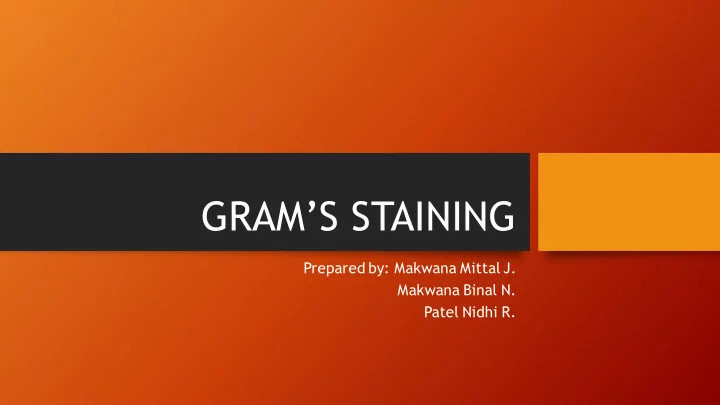

GRAM’S STAINING Prepared by: Makwana Mittal J. Makwana Binal N. Patel Nidhi R.
INTRODUCTION • The Gram stain was developed in 1884 by the Danish bacteriologist Hans Gram stain . • It is a very important differential staining because it separated bacteria into two broad categories namely garm positive and gram positive .
History
FOUR BASIC STEPS OF GRAM STAINING • Applying a primary stain ( Crystal Violet ) to a heat – fixed smear of a bacterial culture . • The addition of Gram’s iodine , which binds to Crystal Violet and traps it in the cell. • Decolonization with ALCOHOL or ACETONE and, • Couter staining with safranin.
PRINCIPALE OF GRAM’S STAINING • Several therories have been proposed to explain the mechanism of Gram’s staining, however the one based on physicochemical nature of the cell wall of bacteria is widely accepted . • Cell wall of gram – negative bacteria are generally thinner than those of gram – positive bacteria. • Gram- negative bacteria possess higher percentage of lipids in their cell wall as compared to gram- positive bacteria . During staining the primary stain Crystal Violet forms complex with mordant iodine ( CV – I ) in the cell wall.
Continue… • When gram – positive bacteria are decolonized with ethanol the alcohol is thought to shrink the pores of the thick peptidoglycan. • Thus , the dye iodine complex is retained during the Short decolonization step and the bacteria remain Violet . In contrast , gram – negative peptidoglycan is very thin , not as highly cross – linked and has larger pores . • Alcohol treatment also may extract enough lipid from the gram – negative wall to increase its porosity further . For these reasons alcohol more readily remove the Crystal Violet – iodine complex from gram – negative bacteria. • These cells subsequently take on the color of counterstain the safranin .
REQUIREMENTS 1. Young cultures of Escherichia coli , Bacillus subtilis & Staphylococcus aureus 2. Crystal Violet stain , Gram’s iodine , 95 % ethanol and safranin stain .
PROCEDURE ( HUCKER’S MODIFICATIONS ) 1. Prepare a heat fixed smear of the culture. 2. Cover the smear with Crystal Violet stain for 1 minute; 3. Add Gram’s iodine to wash off Crystal Violet stain and cover it with iodine till the smear turns coffee brown in color ( approximately 1 minute ) 4. Rinse the slide in running water. 5. Add decolonizing solution drop wise at the upper end of slide held in inclined position , till the Violet color fails to come out from the smear ; for normal smear 10- 15 seconds are enough 6. Rinse the smear with water. 7. Counterstain with safranin for 45 – 60 seconds. 8. Rinse with tap water, drain, blot , air dry and examine .
FACTORS AFFECTING GRAM REACTION 1. Age of bacterial cell : as the ages , gram – posiy cells tend to lose their ability to retain the primary stain and may appear to be gram variable. (i.e. some cells may appear pink ) 2. Decolonization : Excessive decolonization results in loss of primary stain, causing gram- positive organisms to appear gram – negative . Similarly insufficient decolonization will not completely remove CV – I complex gram – positive organisms to appear gram- positive . 3. Excessive fixation : of smear leads to loss in gram positiveness. 4. pH : of the culture medium also influence the gram - reaction. 5. Overcrowding : of cells in the smear affect the result due to improper decolonization .
EXAMPLE OF GRAM’S STAINING BACTERIA • GRAM’S POSITIVE BACTERIA • GRAM’S NEGATIVE BACTERIA • Bacillus subtilis • Escherichia coli • Bacillus megaterium • Azotobacter spp. • Micrococcus luteus • Salmonella typhosa • Staphylococcus aureus • Methylococcus spp. • Micrococcus luteus • Acidaminococcus spp.
Recommend
More recommend